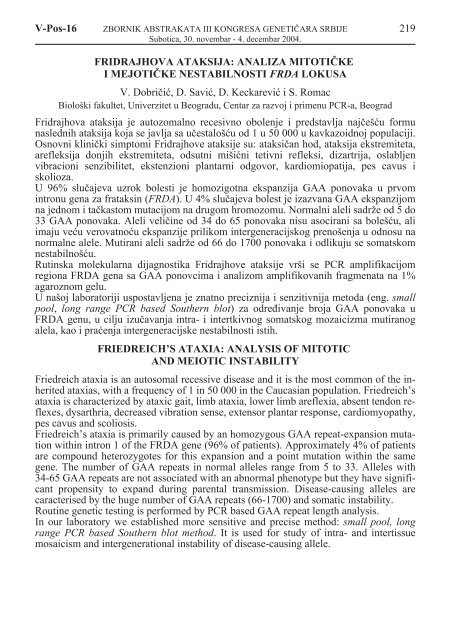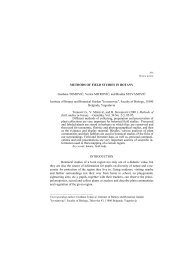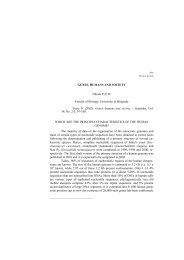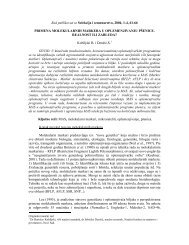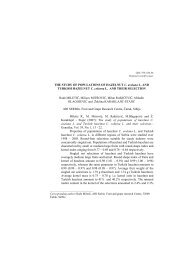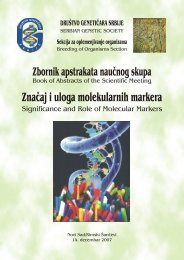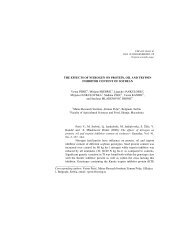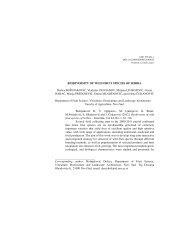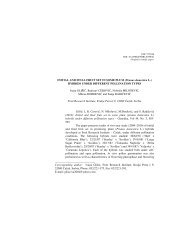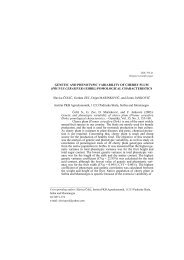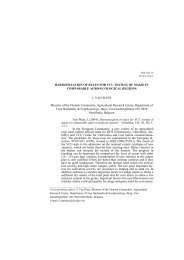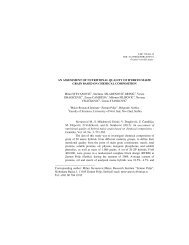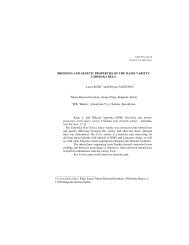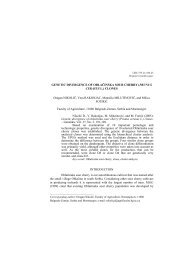Zbornik - Društvo genetičara Srbije
Zbornik - Društvo genetičara Srbije
Zbornik - Društvo genetičara Srbije
Create successful ePaper yourself
Turn your PDF publications into a flip-book with our unique Google optimized e-Paper software.
V-Pos-16 ZBORNIK ABSTRAKATA III KONGRESA GENETIÈARA SRBIJE 219<br />
Subotica, 30. novembar - 4. decembar 2004.<br />
FRIDRAJHOVA ATAKSIJA: ANALIZA MITOTIÈKE<br />
I MEJOTIÈKE NESTABILNOSTI FRDA LOKUSA<br />
V. Dobrièiæ, D. Saviæ, D. Keckareviæ i S. Romac<br />
Biološki fakultet, Univerzitet u Beogradu, Centar za razvoj i primenu PCR-a, Beograd<br />
Fridrajhova ataksija je autozomalno recesivno obolenje i predstavlja najèešæu formu<br />
naslednih ataksija koja se javlja sa uèestalošæu od 1u50000ukavkazoidnoj populaciji.<br />
Osnovni klinièki simptomi Fridrajhove ataksije su: ataksièan hod, ataksija ekstremiteta,<br />
arefleksija donjih ekstremiteta, odsutni mišiæni tetivni refleksi, dizartrija, oslabljen<br />
vibracioni senzibilitet, ekstenzioni plantarni odgovor, kardiomiopatija, pes cavus i<br />
skolioza.<br />
U 96% sluèajeva uzrok bolesti je homozigotna ekspanzija GAA ponovaka u prvom<br />
intronu gena za frataksin (FRDA). U 4% sluèajeva bolest je izazvana GAA ekspanzijom<br />
na jednom i taèkastom mutacijom na drugom hromozomu. Normalni aleli sadre od 5 do<br />
33 GAA ponovaka. Aleli velièine od 34 do 65 ponovaka nisu asocirani sa bolešæu, ali<br />
imaju veæu verovatnoæu ekspanzije prilikom intergeneracijskog prenošenja u odnosu na<br />
normalne alele. Mutirani aleli sadre od 66 do 1700 ponovaka i odlikuju se somatskom<br />
nestabilnošæu.<br />
Rutinska molekularna dijagnostika Fridrajhove ataksije vrši se PCR amplifikacijom<br />
regiona FRDA gena sa GAA ponovcima i analizom amplifikovanih fragmenata na 1%<br />
agaroznom gelu.<br />
U našoj laboratoriji uspostavljena je znatno preciznija i senzitivnija metoda (eng. small<br />
pool, long range PCR based Southern blot) za odreðivanje broja GAA ponovaka u<br />
FRDA genu, u cilju izuèavanja intra- i intertkivnog somatskog mozaicizma mutiranog<br />
alela, kao i praæenja intergeneracijske nestabilnosti istih.<br />
FRIEDREICH’S ATAXIA: ANALYSIS OF MITOTIC<br />
AND MEIOTIC INSTABILITY<br />
Friedreich ataxia is an autosomal recessive disease and it is the most common of the inherited<br />
ataxias, with a frequency of 1 in 50 000 in the Caucasian population. Friedreich’s<br />
ataxia is characterized by ataxic gait, limb ataxia, lower limb areflexia, absent tendon reflexes,<br />
dysarthria, decreased vibration sense, extensor plantar response, cardiomyopathy,<br />
pes cavus and scoliosis.<br />
Friedreich’s ataxia is primarily caused by an homozygous GAA repeat-expansion mutation<br />
within intron 1 of the FRDA gene (96% of patients). Approximately 4% of patients<br />
are compound heterozygotes for this expansion and a point mutation within the same<br />
gene. The number of GAA repeats in normal alleles range from 5 to 33. Alleles with<br />
34-65 GAA repeats are not associated with an abnormal phenotype but they have significant<br />
propensity to expand during parental transmission. Disease-causing alleles are<br />
caracterised by the huge number of GAA repeats (66-1700) and somatic instability.<br />
Routine genetic testing is performed by PCR based GAA repeat length analysis.<br />
In our laboratory we established more sensitive and precise method: small pool, long<br />
range PCR based Southern blot method. It is used for study of intra- and intertissue<br />
mosaicism and intergenerational instability of disease-causing allele.


